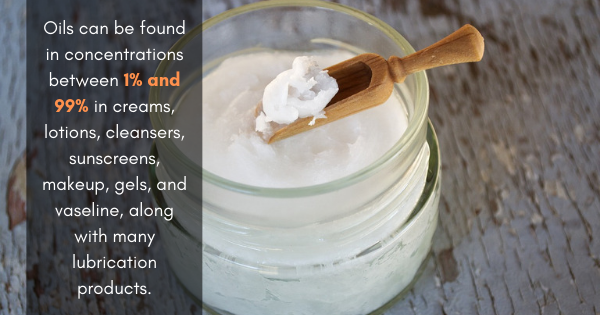Oils are essential ingredients in an extensive range of products. They can be found in concentrations between 1% and 99% in creams, lotions, cleansers, sunscreens, makeup, gels, and vaseline, along with many lubrication products. Therefore, finding quality mineral oil ingredients is paramount for manufacturers.
Base Oils
The quality of base oil depends on the manufacturing process. As an authorized distributor for Chevron, Renkert Oil supplies premium base oils evaluated to be exceptionally stable in oxidation, low in volatility at given grades of viscosity, and essentially free of sulfur. These base oils are ideal choices when it comes to choosing material for a variety of different products, encompassing automotive purposes as motor oils, industrial processes, and feedstock for food grade white oils, among other uses.
Renoil White Mineral Oils
Renoil white mineral oils are free of color, odor and taste – a mixture of saturated paraffinic and naphthenic hydrocarbons with a range of viscosity from 60 to 1700 SUS at a temperature of 100 degrees F.
Applications may include use in products involving direct contact with food, prolonged contact with skin, and minimization of odor and stains.
Renoil Low Volatility Mineral Oils
Low volatility mineral oils are paraffinic and highly refined. Their properties include extremely low volatility, low temperature fluidity, and high viscosity despite the absence of thickeners. These oils are also odorless and tasteless, and colorless.
Applications may include use in products such as low fogging thermoplastic elastomer extenders, grease components, lubricants for high and low temperatures, and oils for heat transfer, compressors, and wind turbines.
Renoil High Viscosity White Mineral Oils
High viscosity white mineral oils are clear and highly refined with low volatility and extremely high stability in oxidation. They are odorless, tasteless, colorless, chemically inert, and UV stable.
Applications often involve the addition of these oils into plastics, either as internal or external lubricants or as polymer extenders or softeners. These food grade white oils are used in mold release agents, pigment dispersing agents, catalyst carrier oils in polymer production, heat transfer oils, and low fogging plasticizers.
Process Oils
Process oils provide high stability in oxidation and low volatility for its viscosity grade. Although they may have slight color, the color remains consistent despite exposure to UV or to heat.
These oils reduce mixing time, generate less heat, and maximize component dispersion. They also increase volume of a product while maintaining original or improving physical properties. Because of their consistent color, these oils are optimal with applications regarding the minimization of stains and discoloration. Since these oils are lower in viscosity for given volatility levels, in processing, less oil is necessary, potentially lowering manufacturing costs.

